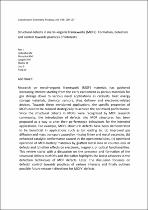 ResearchSpace
ResearchSpace
Structural defects in metal–organic frameworks (MOFs): Formation, detection and control towards practices of interests
JavaScript is disabled for your browser. Some features of this site may not work without it.
- ResearchSpace
- →
- Research Publications/Outputs
- →
- Journal Articles
- →
- View Item
| dc.contributor.author |
Ren, Jianwei

|
|
| dc.contributor.author |
Ledwaba, Mpho V

|
|
| dc.contributor.author |
Musyoka, Nicholas M

|
|
| dc.contributor.author |
Langmi, Henrietta W

|
|
| dc.contributor.author |
Mathe, Mahlanyane K

|
|
| dc.contributor.author |
Liao, S

|
|
| dc.contributor.author |
Pang, W

|
|
| dc.date.accessioned | 2017-11-06T12:54:00Z | |
| dc.date.available | 2017-11-06T12:54:00Z | |
| dc.date.issued | 2017-10 | |
| dc.identifier.citation | Ren, J. et al. 2017. Structural defects in metal–organic frameworks (MOFs): Formation, detection and control towards practices of interests. Coordination Chemistry Reviews, vol. 349: 169-197 | en_US |
| dc.identifier.issn | 0010-8545 | |
| dc.identifier.uri | http://www.sciencedirect.com/science/article/pii/S0010854517301984 | |
| dc.identifier.uri | https://doi.org/10.1016/j.ccr.2017.08.017 | |
| dc.identifier.uri | http://hdl.handle.net/10204/9731 | |
| dc.description | Copyright: 2017 Elsevier. Due to copyright restrictions, the attached PDF file only contains the abstract of the full text item. For access to the full text item, kindly consult the publisher's website. | en_US |
| dc.description.abstract | Research on metal–organic framework (MOF) materials has gathered increasing interest starting from the early excitement as porous materials for gas storage down to various novel applications as catalysts, heat energy storage materials, chemical sensors, drug delivery and electronic-related devices. Towards these envisioned applications, the specific properties of MOFs need to be tailored strategically to achieve the optimized performance. Since the structural defects in MOFs were recognized by MOF research community, the introduction of defects into MOF structures has been proposed as a way to alter their performance behaviours for the intended applications. For example, MOFs structural defects have been demonstrated to be beneficial in applications such as by leading to: (a) improved gas diffusion and mass transport caused by missing linker and metal vacancies, (b) enhanced catalytic performance caused by the open metal sites, (c) optimized operation of MOF-battery materials by grafted metal ions or counter-ions at defects and (d) other effects on electronic, magnetic or optical functionalities. This review starts with a discussion on the presence and formation of the structural defects in MOFs and thereafter highlights the latest advances in the detection techniques of MOF defects. Later, the discussion focusses on defects’ control towards practices of various interests and finally outlines possible future research directions for MOFs’ defects. | en_US |
| dc.language.iso | en | en_US |
| dc.publisher | Elsevier | en_US |
| dc.relation.ispartofseries | Worklist;19680 | |
| dc.relation.ispartofseries | Worklist;19535 | |
| dc.subject | Metal–organic frameworks | en_US |
| dc.subject | Structural defects | en_US |
| dc.subject | Detection | en_US |
| dc.subject | Defects control | en_US |
| dc.title | Structural defects in metal–organic frameworks (MOFs): Formation, detection and control towards practices of interests | en_US |
| dc.type | Article | en_US |
| dc.identifier.apacitation | Ren, J., Ledwaba, M. V., Musyoka, N. M., Langmi, H. W., Mathe, M. K., Liao, S., & Pang, W. (2017). Structural defects in metal–organic frameworks (MOFs): Formation, detection and control towards practices of interests. http://hdl.handle.net/10204/9731 | en_ZA |
| dc.identifier.chicagocitation | Ren, Jianwei, Mpho V Ledwaba, Nicholas M Musyoka, Henrietta W Langmi, Mahlanyane K Mathe, S Liao, and W Pang "Structural defects in metal–organic frameworks (MOFs): Formation, detection and control towards practices of interests." (2017) http://hdl.handle.net/10204/9731 | en_ZA |
| dc.identifier.vancouvercitation | Ren J, Ledwaba MV, Musyoka NM, Langmi HW, Mathe MK, Liao S, et al. Structural defects in metal–organic frameworks (MOFs): Formation, detection and control towards practices of interests. 2017; http://hdl.handle.net/10204/9731. | en_ZA |
| dc.identifier.ris | TY - Article AU - Ren, Jianwei AU - Ledwaba, Mpho V AU - Musyoka, Nicholas M AU - Langmi, Henrietta W AU - Mathe, Mahlanyane K AU - Liao, S AU - Pang, W AB - Research on metal–organic framework (MOF) materials has gathered increasing interest starting from the early excitement as porous materials for gas storage down to various novel applications as catalysts, heat energy storage materials, chemical sensors, drug delivery and electronic-related devices. Towards these envisioned applications, the specific properties of MOFs need to be tailored strategically to achieve the optimized performance. Since the structural defects in MOFs were recognized by MOF research community, the introduction of defects into MOF structures has been proposed as a way to alter their performance behaviours for the intended applications. For example, MOFs structural defects have been demonstrated to be beneficial in applications such as by leading to: (a) improved gas diffusion and mass transport caused by missing linker and metal vacancies, (b) enhanced catalytic performance caused by the open metal sites, (c) optimized operation of MOF-battery materials by grafted metal ions or counter-ions at defects and (d) other effects on electronic, magnetic or optical functionalities. This review starts with a discussion on the presence and formation of the structural defects in MOFs and thereafter highlights the latest advances in the detection techniques of MOF defects. Later, the discussion focusses on defects’ control towards practices of various interests and finally outlines possible future research directions for MOFs’ defects. DA - 2017-10 DB - ResearchSpace DP - CSIR KW - Metal–organic frameworks KW - Structural defects KW - Detection KW - Defects control LK - https://researchspace.csir.co.za PY - 2017 SM - 0010-8545 T1 - Structural defects in metal–organic frameworks (MOFs): Formation, detection and control towards practices of interests TI - Structural defects in metal–organic frameworks (MOFs): Formation, detection and control towards practices of interests UR - http://hdl.handle.net/10204/9731 ER - | en_ZA |





